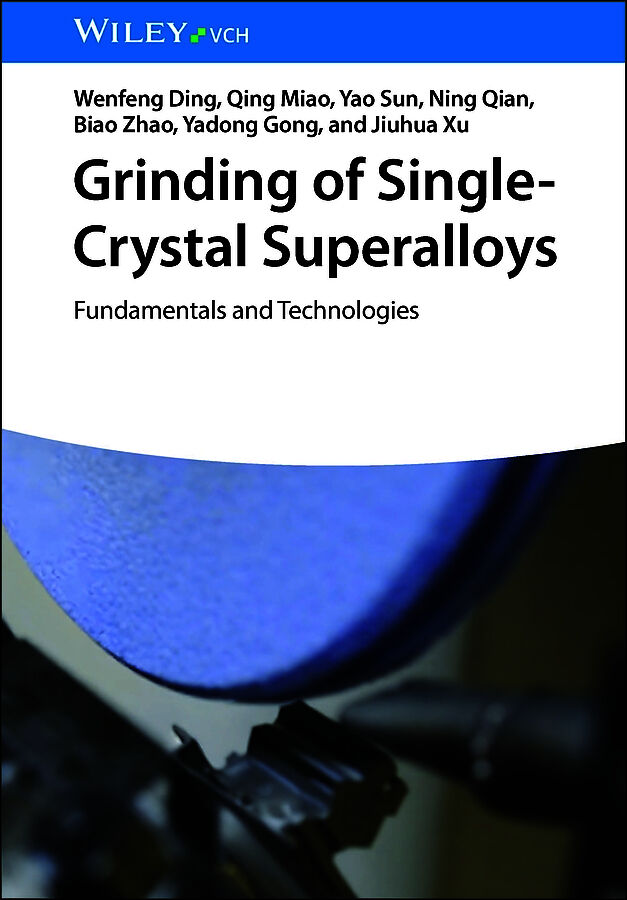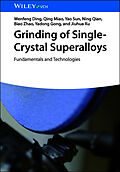

Grinding of Single-Crystal Superalloys
Beschreibung
This book provides a comprehensive understanding of grinding technology for single-crystal nickel-based superalloys. It also explores and analyzes grinding mechanisms and characteristics using both theoretical and simulation approaches. The grinding behavior i...Format auswählen
- Fester EinbandCHF 177.40
Wird oft zusammen gekauft
Andere Kunden kauften auch
Beschreibung
This book provides a comprehensive understanding of grinding technology for single-crystal nickel-based superalloys. It also explores and analyzes grinding mechanisms and characteristics using both theoretical and simulation approaches. The grinding behavior in conventional and micro grinding processes are evaluated and compared. Moreover, it assesses the surface integrity of single-crystal nickel-based superalloys under different grinding conditions. Lastly, simulation and theoretical models for predicting temperature and residual stresses in profile grinding, facilitating optimization and control are summarized and validated.
Autorentext
Prof. Wenfeng Ding dedicated his research in the field of advanced manufacturing theory and technologies with the special interest in the field of hybrid-energy cutting/grinding technologies and facilities, novel cooling technologies, and advanced cutting/grinding of aerospace alloys. Prof. Ding has coordinated several major funds at the national level, including National Natural Science Foundation of China, Key Basic Research of the Ministry of Science and Technology of China (Aero- and gas turbine engines), and Key Basic Research of Civil Aircraft. Prof. Ding has 47 authorized patents, published two books and more than 150 articles indexed by SCI in the peer-reviewed journals, among which 18 papers were awarded as the ESI highly-cited papers.
Dr. Qing Miao dedicated his research in the field of advanced material microstructure characterization, high-quality and high-efficiency grinding technology of nickel-based superalloys. Dr. Miao has received several supports from both local government funding and enterprise funding. Until now, Dr. Miao has published more than 40 research papers and 10 authorized national patents.
Dr.Yao Sun has been engaged in the research of the basic theory and technology of grinding process of difficult-to-machine materials, intelligent manufacturing and micro-scale machining. Dr. Sun has won a number of national and provincial funds such as National Natural Science Foundation of China, National Postdoctoral Foundation project, etc. Dr. Sun has published more than 30 academic papers as the first or corresponding author indexed by SCI and EI, among which one paper were awarded as ESI highly-cited paper and one hot paper.
Ning Qian is now an associate professor at Nanjing University of Aeronautics and Astronautics (NUAA). He achieved his Ph.D. from the same university. In 2021, he was granted by the China Postdoctoral Science Foundation. He also achieved the Jiangsu Province Science and Technology Award, Inventions Geneva Bronze medal, and Metal-cutting Innovation Award.
Biao Zhao is currently an associate professor of Mechanical Engineering and Master's Tutor at Nanjing University of Aeronautics and Astronautics, China. He was selected as a participant in the China Association for Science and Technology Young Talent Lifting Project and recognized as an Outstanding Postdoctoral Fellow by Jiangsu Province.
Prof. Yadong Gong has been engaged in teaching, research and postgraduate training in grinding and precision machining, digital manufacturing and micro-scale machining. Prof. Gong has edited and published 6 books, won a number of national and provincial funds, teaching achievements and scientific and technological progress awards, and published more than 120 academic papers indexed by SCI, EI and ISTP.
Prof. Jiuhua Xu has been engaged in teaching and research in grinding of difficult-to-cut materials. Prof. Xu has published two books and over 300 papers indexed by SCI and EI, sponsored some research projects from national natural science foundations, and won some scientific and technological progress awards.
Inhalt
Foreword
Preface
PART I GRINDING MECHANISM OF SINGLE-CRYSTAL NICKEL ALLOY
Chapter 1 Introduction
1.1 Development and practical application of single-crystal nickel alloy
1.2 Advantages of grinding technology of single crystal nickel alloy
1.3 High-efficiency grinding technology development of single crystal nickel alloy
1.4 Micro-grinding technology development of single-crystal nickel alloy
1.5 Contents of this book
Chapter 2 Removal mechanism of single-crystal nickel alloy in high-efficiency grinding
2.1 Yield criterion and failure criterion of single-crystal nickel alloy
2.2 Simulation model and experiment conditions
2.3 Simulation results on material removal by multi abrasive grains
2.4 Experimental verification of simulation results
Chapter 3 Plastic deformation mechanism of single-crystal nickel alloy in micro-grinding
3.1 Verification of plastic deformation mechanism in micro-grinding materials
3.2 Microscale Debris in Micro - grinding of Single - crystal Nickel Alloy
PART II GRINDABILITY OF SINGLE-CRYSTAL NICKEL ALLOYS
Chapter 4 Grinding force evaluation
4.1 Grinding force in surface grinding
4.2 Grinding force in profile grinding
4.3 Grinding Force in Micro-grinding
Chapter 5 Grinding temperature evaluation
5.1 Grinding temperature in surface grinding
5.2 Grinding temperature in profile grinding
5.3 Grinding Temperature in Micro-grinding
Chapter 6 Grinding wheel wear evaluation
6.1 Grinding wheel wear in surface grinding
6.2 Grinding wheel wear in profile grinding
6.3 Grinding Wheel Wear in Micro-Grinding
PART III SURFACE INTEGRITY BY HIGH-EFFICIENCY GRINDING
Chapter 7 Surface and subsurface microstructures in high-efficiency grinding
7.1 Surface microstructure and surface roughness in surface grinding
7.2 Subsurface microstructure in surface grinding
7.3 Surface microstructure and surface roughness in profile grinding
7.4 Subsurface microstructure in profile grinding
Chapter 8 Subsurface nanostructures in high-efficiency grinding
8.1 Subsurface nanostructures in profile grinding
8.2 Analysis on formation mechanism of nanostructures
8.3 Plastic Deformation and microstructure evolution of single-crystal nickel superalloy
Chapter 9 Microhardness and residual stresses in high-efficiency grinding
9.1 Microhardness in surface grinding
9.2 Microhardness in profile grinding
9.3 Residual stresses in profile grinding
Chapter 10 Fretting wear behavior of the machined surface in high-efficiency grinding
10.1 Friction coefficient, wear volume and wear rate during fretting
10.2 Surface and subsurface microstructure during fretting
10.3 Analysis on fretting wear evolution of the ground surface
PART IV SURFACE INTEGRITY IN MICRO-GRINDING
Chapter 11 Surface roughness in micro-grinding
11.1 Theoretical model of surface roughness
11.2 Influence of grinding parameters
11.3 Influence of material anisotropy of nickel-based single-crystal superalloy
11.4 Influence of different crystal orientations of nickel-based single-crystal superalloy
11.5 Influence of grinding methods
Chapter 12 Ground surface and subsurface damage in micro-grinding
12.1 Influence of grinding parameters
12.2 Influence of working fluid
Chapter 13 Subsurface microstructure and recrystallization in micro-grinding
13.1 Subsurface microstructure in the micro-grinding process
13.2 Subsurface recrystallization in micro-grinding
PART V SIMULATION, OPTIMIZATION AND CONTROL IN GRINDING OF SINGLE-CRYSTAL TURBINE BLADE ROOT
Chapter 14 Temperature field in grinding of single-crystal turbine blade root
14.1 FE model for grinding temperature simulation
14.2 Thermal analysis for grinding temperature simulatio
